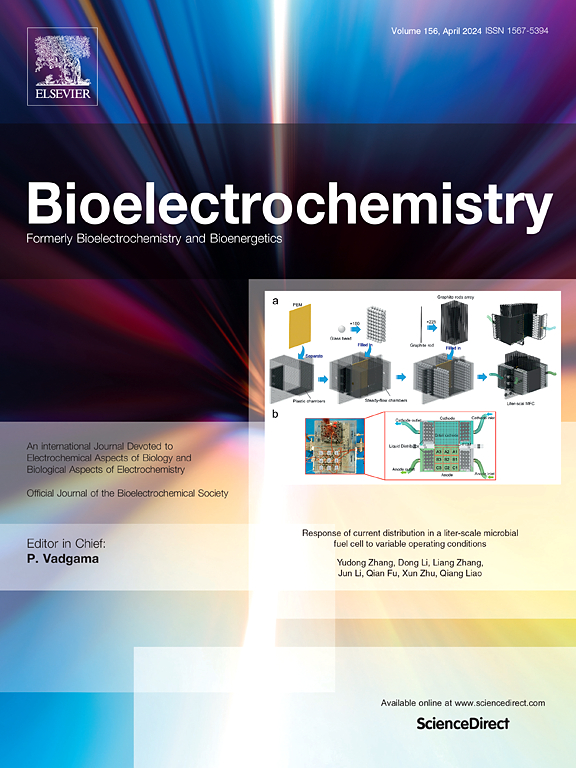Electrochemical biosensor based on composite of gold nanoparticle/reduced-graphene oxide/graphitic carbon nitride and a caprolactone polymer for highly sensitive detection of CEA
IF 4.8
2区 化学
Q1 BIOCHEMISTRY & MOLECULAR BIOLOGY
引用次数: 0
Abstract
Carcinoembryonic antigen (CEA) is a broad-spectrum biomarker, and its accurate detection and analysis is important for early clinical diagnosis and treatment. This study aimed to develop a highly sensitive and selective sandwich-type immunosensor based on electrochemical impedance spectroscopy (EIS) for the accurate detection of CEA. A novel composite material, gold nanoparticle/reduced-graphene oxide/graphitic carbon nitride (AuNPs/rGO/g-C3N4), was synthesized with excellent electrical conductivity and a large specific surface area to immobilize biological probes. And ab1-CEA-ab2 formed a sandwich structure of ‘antibody-antigen-antibody’, which ensured the high selectivity of the biosensor. Furthermore, the introduction of caprolactone polymer (DMPA-PCL) significantly amplifies the impedance signal and improves the sensitivity of the analytical method. Scanning electron microscopy, x-ray diffraction, transmission electron microscopy Fourier transform infrared spectroscopy, and ultraviolet–visible spectrophotometry were used to characterise the prepared AuNPs/rGO/g-C3N4 and DMPA-PCL. Under the optimal conditions, the sensor showed good analytical performance for the detection of CEA with a linear range of 100 fg mL−1–100 ng mL−1 and a detection limit of 83.2 fg mL−1. And the sandwich-type immunosensor showed good selectivity and stability for the recognition of CEA in real samples.

基于金纳米粒子/还原氧化石墨烯/氮化石墨碳与己内酯聚合物复合材料的电化学生物传感器,用于CEA的高灵敏度检测
癌胚抗原(CEA)是一种广谱生物标志物,其准确检测和分析对临床早期诊断和治疗具有重要意义。本研究旨在开发一种基于电化学阻抗谱(EIS)的高灵敏度、高选择性三明治型免疫传感器,用于CEA的精确检测。合成了一种新型的纳米金颗粒/还原氧化石墨烯/石墨化碳氮化(AuNPs/rGO/g-C3N4)复合材料,该材料具有优异的导电性和较大的比表面积,可用于固定化生物探针。ab1-CEA-ab2形成了“抗体-抗原-抗体”的夹心结构,保证了生物传感器的高选择性。此外,己内酯聚合物(DMPA-PCL)的引入显著放大了阻抗信号,提高了分析方法的灵敏度。采用扫描电镜、x射线衍射、透射电镜、傅里叶变换红外光谱和紫外可见分光光度法对制备的AuNPs/rGO/g-C3N4和DMPA-PCL进行了表征。在最佳条件下,该传感器对CEA的检测效果良好,线性范围为100 fg mL−1 ~ 100 ng mL−1,检出限为83.2 fg mL−1。该三明治型免疫传感器对实际样品中CEA的识别具有良好的选择性和稳定性。
本文章由计算机程序翻译,如有差异,请以英文原文为准。
求助全文
约1分钟内获得全文
求助全文
来源期刊

Bioelectrochemistry
生物-电化学
CiteScore
9.10
自引率
6.00%
发文量
238
审稿时长
38 days
期刊介绍:
An International Journal Devoted to Electrochemical Aspects of Biology and Biological Aspects of Electrochemistry
Bioelectrochemistry is an international journal devoted to electrochemical principles in biology and biological aspects of electrochemistry. It publishes experimental and theoretical papers dealing with the electrochemical aspects of:
• Electrified interfaces (electric double layers, adsorption, electron transfer, protein electrochemistry, basic principles of biosensors, biosensor interfaces and bio-nanosensor design and construction.
• Electric and magnetic field effects (field-dependent processes, field interactions with molecules, intramolecular field effects, sensory systems for electric and magnetic fields, molecular and cellular mechanisms)
• Bioenergetics and signal transduction (energy conversion, photosynthetic and visual membranes)
• Biomembranes and model membranes (thermodynamics and mechanics, membrane transport, electroporation, fusion and insertion)
• Electrochemical applications in medicine and biotechnology (drug delivery and gene transfer to cells and tissues, iontophoresis, skin electroporation, injury and repair).
• Organization and use of arrays in-vitro and in-vivo, including as part of feedback control.
• Electrochemical interrogation of biofilms as generated by microorganisms and tissue reaction associated with medical implants.
 求助内容:
求助内容: 应助结果提醒方式:
应助结果提醒方式:


